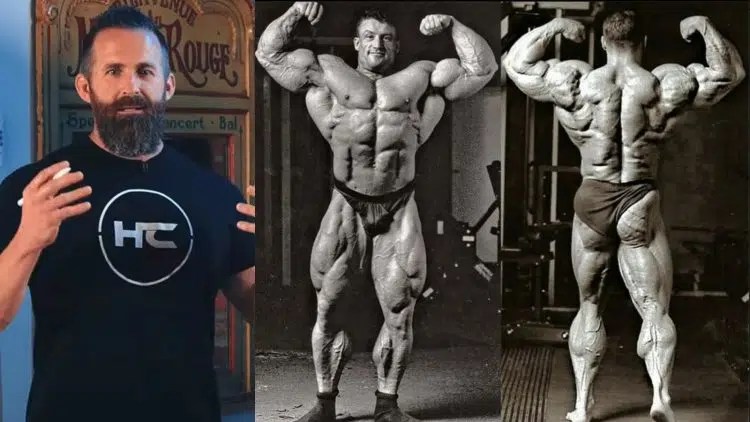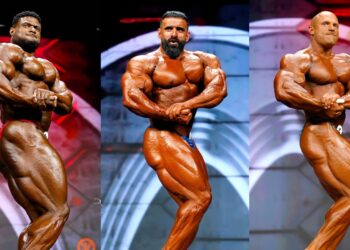Even in retirement, fans and bodybuilding enthusiasts are enthralled by the intensity and craftiness of Dorian Yates‘ training regimen. Taking to YouTube, hypertrophy coach Joe Bennett analyzed ‘The Shadow’s’ famous ‘blood and guts’ shoulder and triceps workout, offering insight into his technique and execution.
In the 1990s, Dorian Yates dominated the Men’s Open landscape with a densely conditioned one-of-a-kind physique. Having denied aesthetic mainstays of the category like Flex Wheeler and Shawn Ray a chance at holding the Sandow trophy, Yates was revered for his spectacular back and muscle detail.
En route to building his sterling legacy, Yates managed to win six Mr. Olympia titles. Sporting undeniable longevity today, the bodybuilding community remains curious about the measures that turned him into such a powerhouse, which prompted bodybuilding coach Joe Bennett to take a closer look at his training principles.
Hypertrophy Coach Joe Bennett Breaks Down Dorian Yates’ Shoulder/Triceps Blood and Guts Workout
Find Bennett’s insight into Yates’ workout below:
Level Up Your Fitness: Join our 💪 strong community in Fitness Volt Newsletter. Get daily inspiration, expert-backed workouts, nutrition tips, the latest in strength sports, and the support you need to reach your goals. Subscribe for free!
Overhead press
When it comes to overhead presses, Bennett believes lifters of all skill levels would benefit from a variation that feels most comfortable.
“One is just pick the overhead press that’s the most comfortable. I think people get hyper-fixated on whatever, you have to do a barbell, you have to do a dumbbell. What I’m looking at is this type of stuff. I’m looking at his upper arm position and his shoulder angle.”
“You want something basically that takes your shoulder through a pretty good range of motion so if I look at something, you’re going to do a press, people do this thing where they stop right at 90 degrees, I don’t know where somebody made up that rule, they said something magical about stopping at 90, you know that’s a position of high joint twerk, where again, that moment arm type of thing is far from your joint but it stays consistently far all through these ranges.”
Lateral raise
Bennett says Yates sitting down during lateral raises allowed him to achieve a better range of motion while recruiting fewer secondary muscles throughout the sets.
“One of the things I love about this and not a lot of people these days do, they don’t like it, but Dorian is seated,” said Bennett. “I’m assuming he’s seated because he realizes the more stuff that moves, so if you walk through gyms all across the US, how do people do lateral raises?
Oftentimes, people involve their hips unnecessarily during lateral raises, explains Bennett.
“They involve their hips drastically. They involve their knees, I even see people coming up on their toes, they are using as much stuff as possible to get that weight moving. As opposed to having the whole goal in my opinion should have your delt doing all the work.”
Cable movement for delts
Bennett underlined that Yates only opted for three exercises to properly hit his delts, which he says is ‘enough stimulus.’
“Dorian is using a cable,” shares Bennett. “He moves next to a cable. I find it funny. This is the whole delt workout. This is the end of the delts. We do some trap work after this. We got three motions. He does the overhead press. In my opinion, between what you’re doing for chest and doing an overhead press that should be more than enough stimulus for front delt and Dorian also agreed. But he does two motions for side delts.”
Shrugs
Bennett explains Yates’ elbow positioning during shrugs which allow for a better range of motion.
“The thing you guys probably notice here is a pretty significant elbow bend as he shrugs. I actually like that. If you can do it where you keep everything fixed, I think that’ll probably allow your shoulder blades to get in a better position for a little bit more range of motion.”
“There is going to be a little bit of elbow tax or a little bit of rear delt tax, it’s going to be so minimal it doesn’t really matter.”
Tricep Pressdowns
He described tricep pressdowns as a ‘compound motion’ more than a ‘purely isolated extension.’
“The funny thing is if you’re trying to keep it elbow-friendly and you’re going to do a fixed closed grip, you pretty much have to turn it into a press or it’s actually going to be really rough on the elbows. It’s almost for a lack of a better word a little bit of a compound motion more than it is a purely isolated extension. You can’t tell as much from the side but you can certainly see it more from the front.”
Bennett clarifies that if you have a bigger body, you might benefit from a more comfortable range of motion, recommending something ‘single-arm.’
“I’m not opposed to any of that. Again, it’s arguably for huge guys, maybe just not as efficient,” adds Bennett. “If you’re bigger you might just be better off going straight to something single-arm or something that allows for a more comfortable range of motion.”
Barbell skullcrushers
He complimented Yates’ form on barbell skullcrushers and recommended the movement as long as your elbows could handle the tension.
“If your elbows allowed, I would rather you start with a motion like this where is again, it’s a little bit more, the reason I prefer this, is this is beautiful right here. Some people like to go behind the head, because he’s keeping a little bit of tension at the top but if you go right over here and that weight stacks straight over your face there’s going to be no tension at the top, which is no big deal at all,” said Joe Bennett.
Reverse grip cable extension
Lastly, Bennett examined Yates’ range of motion during reverse grip cable extensions, emphasizing that the load was at its heaviest during the mid-range of each rep.
“It’s the heaviest in the mid-range, still significantly heavy in the lengthened range, then we he comes to arguably the least important range of motion, where do we have that line of force, here [torso] and where is the elbow joint, right here [aligned].”
Hypertrophy coach Joe Bennett isn’t the only high-profile trainer assessing the exercise techniques used by Dorian Yates. Exercise scientist Dr. Mike Israetel recently examined ‘The Shadow’s’ blood and guts back workout, offering tips and insight into the training program.
Sporting next-level longevity and optimal health at 62, it’s evident that Dorian Yates’ training methods paid off with more than just six Olympia titles. Bennett believes his approach to training was not only effective but carefully calculated.









